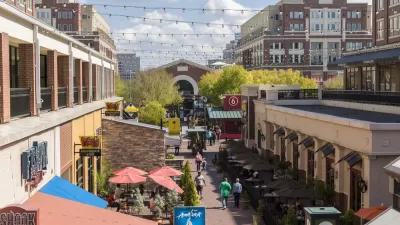Brightly lit pedestrian and commercial districts like Times Square and Shibuya Crossing in Tokyo are some of the most famous urban environments in the world. But that doesn’t mean they work in every city.

Mimi Kirk reports for CityLab on the efforts in Atlanta to develop a "bright lights district" akin to Times Square in New York. "The organization Central Atlanta Progress (CAP) is spearheading the effort to relax signage restrictions so that property owners can go bigger and brighter," writes Kirk.
Currently the city's zoning code caps signs at a maximum of 200 square feet. The group is pushing to allow bigger and brighter signs.
An earlier article by Amy Wenk reports on more of the details of the city ordinance that would enable the bright lights district. According to Wenk, the district "would stretch from the Georgia World Congress Center east to Piedmont Avenue, and from the attractions at Ivan Allen Jr. Boulevard south to Underground Atlanta. The district would include the new Mercedes-Benz Stadium, Philips Arena, The Tabernacle and Georgia Aquarium." The ordinance could go before the Atlanta City Council for a vote as soon as January.
In the article for CityLab, Kirk supplements a discussion of the details of the new ordinance with insight from Margaret Petty, head of the School of Design at Australia’s Queensland University of Technology, and Josiane Meier, lecturer at the Technical University of Berlin and co-editor of Urban Lighting, Light Pollution, and Society. Both those experts throw cold water on the idea that a bright lights district will attract tourists and visitors without additional key ingredients like density. There are also drawbacks to the environmental impact of bigger and brighter signs.
FULL STORY: Atlanta's Plan to Create Its Own Times Square

Planetizen Federal Action Tracker
A weekly monitor of how Trump’s orders and actions are impacting planners and planning in America.

Congressman Proposes Bill to Rename DC Metro “Trump Train”
The Make Autorail Great Again Act would withhold federal funding to the system until the Washington Metropolitan Area Transit Authority (WMATA), rebrands as the Washington Metropolitan Authority for Greater Access (WMAGA).

DARTSpace Platform Streamlines Dallas TOD Application Process
The Dallas transit agency hopes a shorter permitting timeline will boost transit-oriented development around rail stations.

Renters Now Outnumber Homeowners in Over 200 US Suburbs
High housing costs in city centers and the new-found flexibility offered by remote work are pushing more renters to suburban areas.

The Tiny, Adorable $7,000 Car Turning Japan Onto EVs
The single seat Mibot charges from a regular plug as quickly as an iPad, and is about half the price of an average EV.

Supreme Court Ruling in Pipeline Case Guts Federal Environmental Law
The decision limits the scope of a federal law that mandates extensive environmental impact reviews of energy, infrastructure, and transportation projects.
Urban Design for Planners 1: Software Tools
This six-course series explores essential urban design concepts using open source software and equips planners with the tools they need to participate fully in the urban design process.
Planning for Universal Design
Learn the tools for implementing Universal Design in planning regulations.
Municipality of Princeton
Roanoke Valley-Alleghany Regional Commission
City of Mt Shasta
City of Camden Redevelopment Agency
City of Astoria
Transportation Research & Education Center (TREC) at Portland State University
US High Speed Rail Association
City of Camden Redevelopment Agency
Municipality of Princeton (NJ)




























